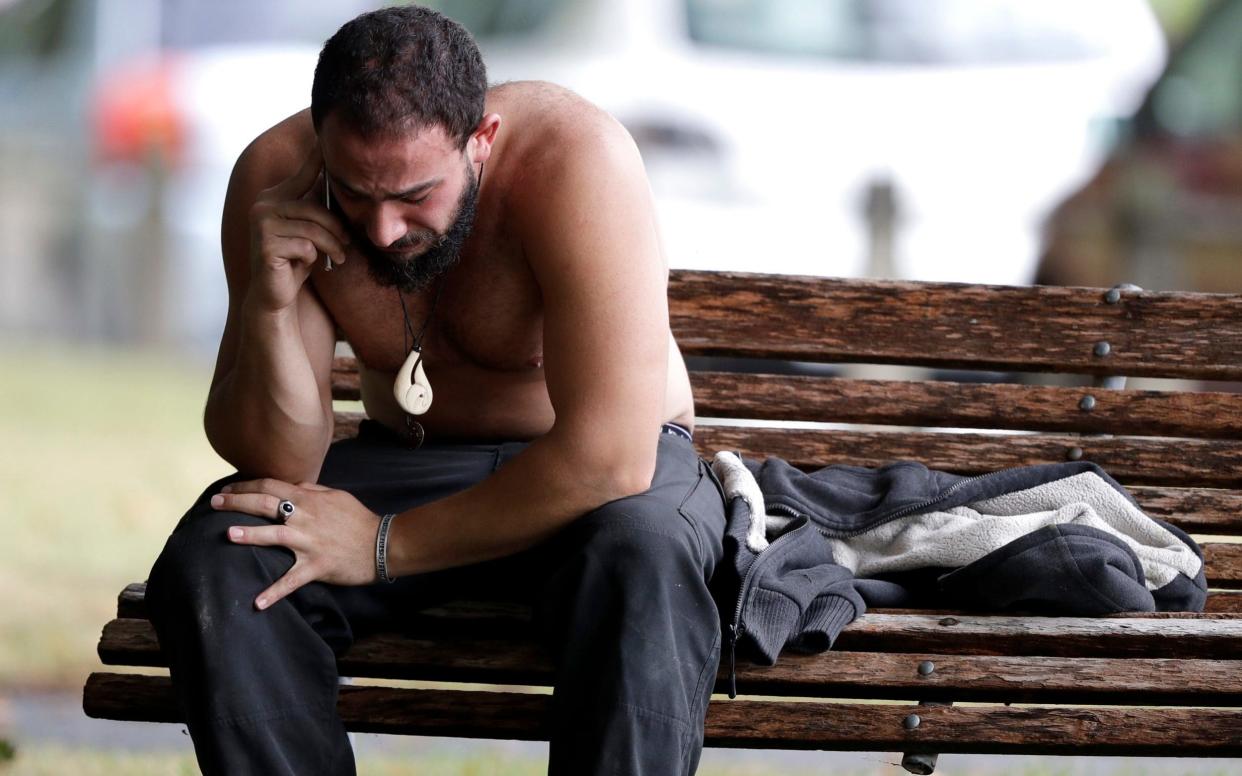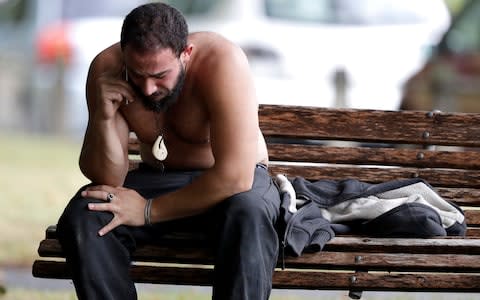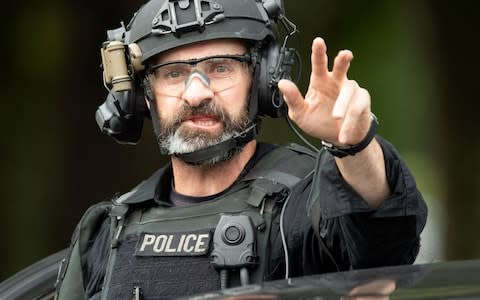'Let's get this party started': 17 minutes of terror as gunman coolly launched massacre that has rocked New Zealand to its core

You could, as one of the survivors said afterwards, hear a pin drop as the faithful settled down to listen to the imam’s sermon. Then came the deafening crack of gunfire.
Seconds later panic spread through Christchurch’s Al Noor mosque as those inside realised what was happening and tried desperately to flee or find shelter from the bullets.
By the time the carnage ended 41 lay dead, with seven more people killed at an Islamic centre a few miles away. One more died in hospital, where another 48 were being treated, many for gunshot wounds.
As New Zealanders tried to come to terms with the dreadful events they had just witnessed their Prime Minister, Jacinda Ardern, described it as one of the country’s “darkest days”.
The day had started routinely enough, with 300 people attending Friday prayers as normal inside the Al Noor mosque, sited close to Christchurch’s Hagley Park.
One of the congregation, Farid Ahmed, would later describe it as “peaceful, calm and quiet. As it is when the sermon starts, you could hear a pin drop”.
But at 1.40pm, gunfire broke out.
“It started in the main room,” said Mr Ahmed. “I was in the side room, so I didn’t see who was shooting, but I saw that some people were running out to my room where I was in, I saw some people had blood on their body and some people were limping. It was at the moment I realised things were really serious.
It became all too apparent that a gunman was making his way room to room, shooting at anyone he saw, starting with the men's prayer room before moving to the women's section.
Mr Ahmed said the shooting went on “for six minutes or more”.
“I could hear screaming and crying, I saw some people drop dead, some people were running away, I was in a wheelchair, so I couldn’t get anywhere,” he said.
Incredibly Mr Ahmed managed to push himself in his wheelchair into the main part of the mosque after the shooting ended, desperately trying to find his wife and to help others.
“To the right, I saw about 20 plus people, some were dead, some were screaming. On the left there were 10 plus people, some were dead,” he said. “I saw the bullet shells on the floor, so many hundreds.”
Another worshipper, who hid underneath a bench, described how the gunman calmly reloaded at least seven times, targeting those fleeing in terror.
“Bang, bang, bang, then when the bullets stop he [would] change the magazine again,” said Farid Ahmed.
Mohan Ibrahim was also inside the mosque when he heard shots, mistaking them for a short-circuit in the building’s lighting system.
“At first we thought it was an electric shock but then all these people started running. I realised it was a gun shooting,” he said. "I managed to get out. It was like 10 to 15 minutes of continuous shooting. He was changing his gun. I cannot forget the sound of shooting and scenery I saw with my eyes. Innocent people have just died.”

Just metres away from where the killing began were members of the Bangladesh cricket team, who managed to escape with their lives.
Tamim Iqbal Khan, his country’s most successful batsman, later tweeted that the “entire team got saved from active shooters”, adding “please keep us in your prayers”.
From outside Len Peneha, a local resident, had watched in horror as the gunman, dressed in black, entered the mosque. He then heard dozens of shots, followed by people fleeing the building in terror, many of them barefoot, having taken their shoes off before entering the mosque, as is customary for muslims.
As the gunman fled Mr Peneha went inside to try and help the injured, taking five to his nearby home.
“I saw dead people everywhere,” he said. “There were three in the hallway, at the door leading into the mosque, and people inside the mosque.”
Mr Peneha added: “I don't understand how anyone could do this to these people, to anyone. I've lived next door to this mosque for about five years and the people are great, they're very friendly. I just don't understand it."
By now buildings in central Christchurch were in lock-down and at around 3.33pm reports began to emerge of a bomb being found in a car parked in the city’s Strickland Street. Police confirmed they were dealing with a multiple, simultaneous attack.

Then, just a few hours after the massacre at the Al Noor mosque, the horror began again, as a gunman entered the Linwood Islamic Centre, a 10 minute drive away.
Here, at around 5.30pm, seven worshippers were killed when a gunman in a black motorcycle helmet opened fire on 100 people praying inside.
Mark Nichols, the manager of nearby Premium Tyres, reported seeing the gunman ran past his shop before hearing five gunshots from the direction of the mosque. Moments later two of the injured people were carried past on stretchers.
"I seen a guy with a gun running up the road. He's been firing about five shots," Mr Nichols said. "It might have been a shotgun. I didn't get a good look at it, I just cleared off.”
Syed Ahmed described the Linwood gunman “shouting something” as he targeted victims, including several elderly people who had been sitting on chairs because they were unable to kneel for prayers.

One of the attacks was streamed live on Facebook and later circulated on social media.
The 16-minute video showed the man driving towards the Al Noor mosque with several high-powered rifles on the passenger seat of his silver Subaru. On them were written the names of Luca Traini, a far right Italian terrorist jailed for 12 years for shooting and wounding six African migrants in the city of Macerata last year, and Josue Estebanez, a Spanish soldier who stabbed and killed a 16-year-old anti-fascist protester in Madrid in 2007. On the ammunition clips was written 'For Rotherham' in a twisted reference to Muslim grooming gangs.
The gunman appears to be listening to a song called 'Remove Kebab' - first sung by Serbian soldiers in tribute to the war criminal Radovan Karadžić.
As the first song ends a military-style song begins, before the sat nav announces he has reached his destination.
Three minutes into the video, the attacker stops the car and directs the camera at himself and says 'hello lads' before he sets off again.
Approaching the entrance the guman begins firing indiscriminately. At one point a man runs towards him in only to be gunned down.
After walking to the entrance of the mosque, he fires nine shots at one of the worshippers before discarding the gun and producing another. Walking past a man sprawled on the ground he fires quick bursts at anyone he can see, shooting again at a man he has already wounded.
Over the next few minutes he fires at people as they huddled in corners, the cries of the wounded audible inbetween the shooting.
At one stage he returns to the mosque and opens fire again, targeting wounded the make sure they are dead.
The gunman emerges after several minutes and screams can be heard as he fires at the dead and dying outside, including a woman who stumbles into the street shouting for help.
Back in the car, and after apparently driving over the woman he had just killed, he laughs and says the attack “did not go as planned … f*****g Christ”, before adjusting his sat nav and driving away.
‘Fire’, by English rock band The Crazy World Of Arthur Brown, is playing from the car speakers, the singer intoning “I am the god of hellfire!”.
Nathan Cambus, who was travelling on Brougham St, a dual carriageway running east to west through Christchurch, described how armed police gave chase and forced over the gunman’s vehicle.
"They pulled three guns, maybe four, from the car and then they pulled the man out right over the handbrake ... it was pretty scary,” he said.

As police began their investigation into New Zealand’s worst mass shooting it became apparent that the gunman - who before the rampage identified himself online as Brenton Tarrant, an Australian citizen - was a committed white supremacist inspired by the likes of far right terrorist Anders Breivik, who shot dead 69 teenagers on the Norwegian island of Utoya in July 2011 and Darren Osborne, the Cardiff man jailed for life for his murderous attack on London’s Finsbury Park mosque, in June 2017.
On a now-deleted Twitter account, Tarrant posted a link to a 74-page ‘manifesto’ quoting Dylan Thomas’s poem ‘Do not go gentle into that good night’ and containing a long rant about ‘white genocide’.
In it, Tarrant, from the New South Wales town of Grafton, outlines his aim to “create an atmosphere of fear” and to “incite violence” against Muslims.
On Friday, standing outside the Al Noor mosque, in a state of shock, his clothes bloodstained from trying to help the wounded, was Noor Hamzah, who came to New Zealand from Malaysia as a student in the 1980s.
"This is a disaster for New Zealand. A black day," said the 54-year-old. “I can't imagine something like this happening at all. It hasn't sunk into my head yet. I think I'll go into shock over the next couple of days. I hope I am strong enough. We have to bury a lot of people."

